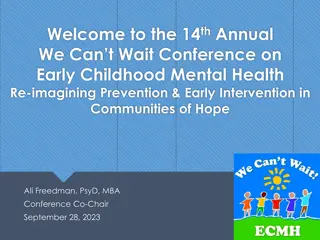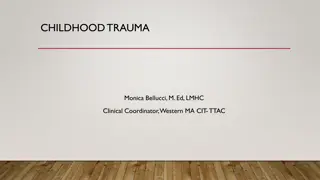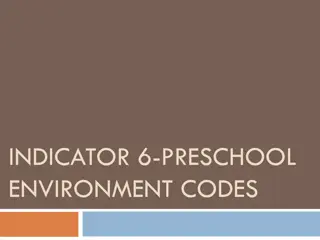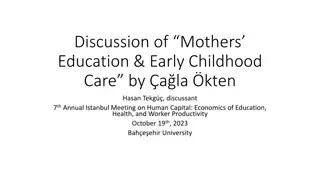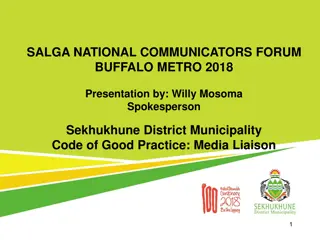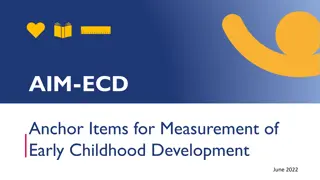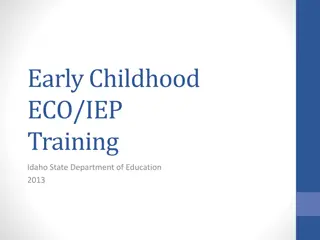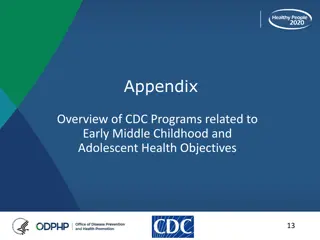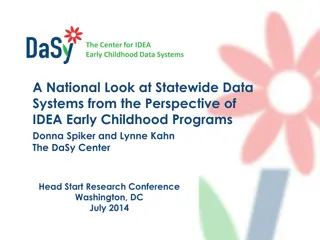Exploring Technology and Interactive Media in Early Childhood Programs
This comprehensive resource delves into the usage of technology and interactive media for children aged birth through 8 years. It covers interactive media, digital literacy, and digital citizenship, addressing concerns, benefits, and guidelines for effective integration in early childhood education. The content emphasizes responsible use and highlights the potential impact on children's development.
Download Presentation

Please find below an Image/Link to download the presentation.
The content on the website is provided AS IS for your information and personal use only. It may not be sold, licensed, or shared on other websites without obtaining consent from the author. Download presentation by click this link. If you encounter any issues during the download, it is possible that the publisher has removed the file from their server.
E N D
Presentation Transcript
Technology and Interactive media as Tools in Early childhood Programs Serving Children from birth through Age8 http://www.naeyc.org/content/technology -and-young-children
Glossary 1. Interactive Media: refers to digital and analog materials, including software programs, applications, broadcast and streaming media, children s television programming, e-books, the Internet, and other forms of content designed to facilitate active and creative use by young children and to encourage social engagement with other children and adults.
Glossary 2.Digital Literacy: Is a term used to encompass both technology and media literacy. 3.Digital Citizenship: refers to the need for adults and children to be responsible digital citizens through an understanding of the use, abuse, and misuse of technology as well as the norms of appropriate, responsible, and ethical behaviors related to online rights, roles, identity, safety, security, and communication.
Statement of Issues 1. Technology and Interactive media are here to stay. 2. There are concerns about whether young children should have access to technology and screen media in early childhood programs. 3. All screens are not created equal. 4. There is conflicting evidence on the value of technology in children s development.
Statement of Issues 5. The appeal of technology can lead to inappropriate uses in early childhood settings. 6. Issues of equity and access remain unresolved.
The Position Technology and interactive media are tools that can promote effective learning and development when they are used intentionally by early childhood educators, within the framework of developmentally appropriate practice. So NAEYC and Fred Rogers offer the following guidelines:
Principles to Guide Appropriate Use of Technology and Interactive Media 1. The use of technology and interactive media should NOT HARM CHILDREN. 2. Developmentally appropriate practices must guide decisions about whether and when to integrate technology and interactive media into early childhood programs. 3.Professional judgment is required to determine if and when a specific use of technology or media is age appropriate, individually appropriate, and culturally and linguistically appropriate.
Principles to Guide Appropriate Use of Technology and Interactive Media 4. Developmentally appropriate teaching practices must always guide the selection of any classroom materials, including technology and interactive media. 5. Appropriate use of technology and media depends on the age, developmental level, needs, interests, linguistic background and abilities of each child.
Principles to Guide Appropriate Use of Technology and Interactive Media 6. Effective use of technology and media are active, hands-on, engaging, and empowering; give the child control; provide adaptive scaffolds to ease the accomplishment of tasks; and are used as one of many options to support children s learning. 7. When used appropriately, technology and media can enhance children's cognitive and social abilities.
Principles to Guide Appropriate Use of Technology and Interactive Media 8. Interactions with technology and media should be playful and support creativity, exploration, pretend play, active play, and outdoor activities. 9. Technology tools can help educators make and strengthen home-school connections. 10. Technology and media can enhance early childhood practice when integrated into the environment, curriculum, and daily routines.
Principles to Guide Appropriate Use of Technology and Interactive Media 11. Assistive technology must be avialable as needed to provide equitable access for children with special needs. 12. Technology tools can be effective for dual language learners by providing access to a family s home language and culture while supporting English language learning. 13. Digital literacy is essential to guiding early childhood educators and parents in the selection, use, integration, and evaluation of technology and interactive media.
Principles to Guide Appropriate Use of Technology and Interactive Media 14. Digital citizenship is an important part of digital literacy for young children. 15. Early childhood educators need training, professional development opportunities, and examples of successful practice to develop the technology and media knowledge, skills, and experience needed to meet the expectations set forth in this statement.
Conclusion It is the role and responsibility of the educator to make informed, intentional, and appropriate choices about if, how, and when technology and media are used. Technology and media should be used as supportive tools. Support is critical and further research is needed to better understand how young children use and learn with technology.










